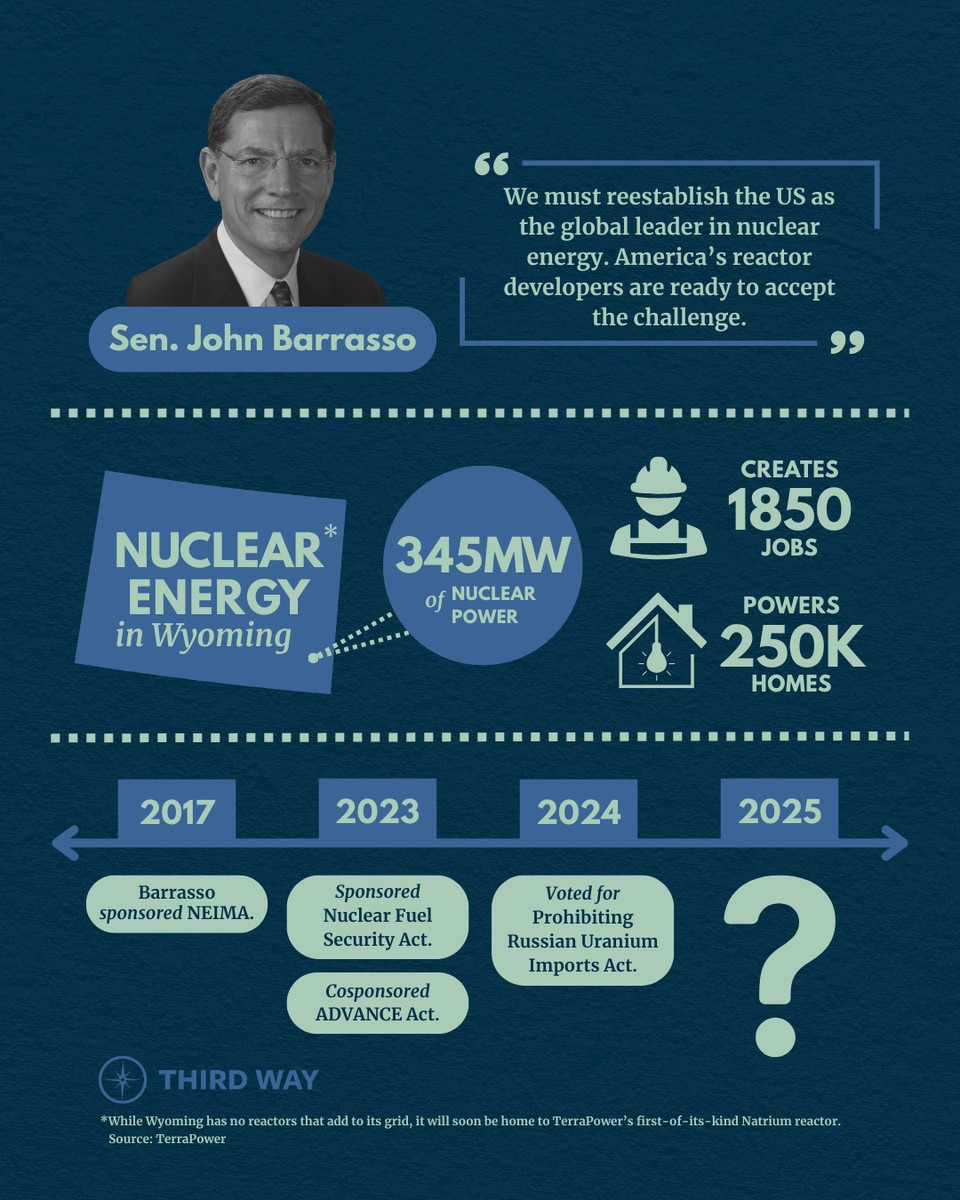Newsletter Published June 13, 2025 · 6 minute read
On the Grid: Can US Nuclear Go Global? 6/13/25
Mary Sagatelova

Click HERE to subscribe to this bi-weekly newsletter.
Welcome back to On the Grid, Third Way’s bi-weekly newsletter, where we’ll recap how we’re working to deploy every clean energy technology as quickly and affordably as possible. We’re excited to have you join us!
We're covering the role of nuclear in US foreign policy (especially in Ukraine) and how domestic policymakers could sabotage that effort before it gets off the ground. Let's dig in.

We’ve long made the case that energy security is closely linked to national security. There’s no clearer example of what that actually means than what's happening right now in Ukraine.
For the past three years, Russia has made energy infrastructure a central target of its war strategy–attacking the Kakhovka dam, bombing thermal plants, pipelines, and substations, and seizing the Zaporizhzhia nuclear plant. Their playbook is clear: energy insecurity creates vulnerabilities they can exploit. That's why, even amid ongoing war, Ukraine is rebuilding its grid and planning ahead.
Why Does This Matter for the US? As we outline in our latest memo, the stakes are inordinately high. An independent, prosperous Ukraine helps ensure global stability, the security of Europe, and could be a vital energy partner for the US and American companies. Ukraine’s energy reconstruction is a strategic opportunity for the US to secure early market share, scale nuclear deployment, and strengthen America’s position in Europe's growing nuclear economy. With clearly defined demand, comprehensive reconstruction plans, and a strong preference for non-Russian technologies, Ukraine is an ideal early market to help the US build a competitive edge in the global nuclear market while reinforcing democratic principles and deterring Russian aggression. Our biggest adversaries, Russia and China, are far ahead, leveraging state-backed financing and fuel deals to shape global norms on safety, non-proliferation, and geopolitical alignment. If the US fails to help Ukraine rebuild its energy system, we risk falling even farther behind.
What Does Energy Reconstruction in Ukraine Look Like? Ukraine has been working for years to cut ties with Russian energy systems, especially its dependence on natural gas and nuclear energy. The US has stepped up on both fronts: American LNG is helping offset shortages caused by the loss of Russian supply, and US nuclear companies are working with Ukraine to fill nuclear fuel gaps. Ukraine’s national utility, Energoatom, has partnered with US-based Westinghouse to diversify its fuel supply and improve reactor safety. In parallel, Ukraine is working with US companies like Holtec and NuScale to establish domestic SMR supply chains. These are still early-stage commitments, but they make it abundantly clear that American nuclear technology could be critical to Ukraine’s energy future.
What We're Doing: Financing is the linchpin–and currently one of the biggest hurdles–for ensuring US nuclear technologies are competitive in overseas markets like Ukraine. To change that, we’re working to strengthen the programs that make American nuclear competitive. That includes the following: the Export-Import Bank of the United States (EXIM), the US International Development Finance Corporation, the US Trade and Development Agency, and others. With decades of experience supporting complex infrastructure projects abroad, these agencies are some of the most critical levers at our disposal to support nuclear exports in Ukraine and elsewhere. But to do so, it needs the authority, resources, and flexibility to meet the moment.
Our newest memo outlines the importance of reinforcing these agencies and how expanding their mandates, authorities, and flexibility helps support nuclear exports at scale. Additionally, to raise the profile of EXIM and its capabilities to support US nuclear exports and make the case for action ahead of EXIM reauthorization next year, we put together a new infographic and are ensuring it gets in front of key policymakers and stakeholders.

As the budget reconciliation process moves into the Senate, the future of American energy policy is now in the hands of a handful of Senate Republicans, and there’s a lot at stake.
The Damage: The current House bill is a blueprint for self-sabotage. It includes damaging rollbacks to tech-neutral tax credits, cuts to critical consumer energy efficiency programs, and overly burdensome Foreign Entity of Concern (FEOC) restrictions that actively undermine our economic competitiveness. At a moment when electricity demand is on the rise and countries are serious about scaling clean energy, the “big, beautiful bill” pulls the rug out from under the energy sector. As troubling, it would kneecap the US’s growing role in clean energy manufacturing and deployment. Nuclear will be hit especially hard.
The Details: The House bill, as written, poses a unique threat to America’s nuclear industry just as it's picking up speed. As the Senate prepares its own version of the tax package, they have the ability to take explicit action to:
- Safeguard the technology-neutral tax credits that support early commercial deployment,
- Keep credits in place before phase-out begins,
- Allow transferability for the full duration of the tax credits,
- Define clearer and more workable FEOC provisions, and
- Protect key funding for the Department of Energy’s Loan Programs and Nuclear Energy Offices.
The Deciders: Several Senate Republicans now weighing in on this bill have long led the charge for American nuclear leadership. Senator John Barrasso (R-WY), for example, not only sponsored the Nuclear Energy Innovation and Modernization Act (NEIMA), which modernized licensing pathways for advanced nuclear reactors, and co-sponsored the Accelerating Deployment of Versatile, Advanced Nuclear for Clean Energy (ADVANCE) Act to accelerate nuclear deployment. Senator Barrasso has made it clear, time and time again, that nuclear energy is central to America’s clean energy future. Now, Senator Barrasso and others have a choice: defend that legacy or let one of the most damaging attacks on American nuclear go unchallenged.
Gutting tax credits and slashing deployment support doesn’t just hurt our economy, it undermines US foreign policy. The decisions made in the reconciliation process will reverberate far beyond our borders. They will determine whether the US can compete globally and whether American nuclear can step up in critical places like Ukraine to offset Russian and Chinese influence.


- Michael Ross and Erik Voeten in Foreign Affairs make the case that America’s position as a top oil and gas exporter and newfound geopolitical leverage has pushed the US to behave like a petro-state—more inward-focused, less cooperative, and more likely to leverage energy for short-term advantages—and the impact that behavior has on other US exports.
- Rhodium Group outlines three consequences of Republicans’ current budget reconciliation plan, highlighting investment lost across the US, stalled manufacturing growth, and risks to emerging technologies.
- Robinson Meyer and Jessie Jenkins, on Heatmap’s Shift Key podcast, chat with Jessica Green, a political science professor at the University of Toronto, about radical pragmatism in climate action and asset management of energy infrastructure.

